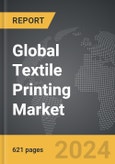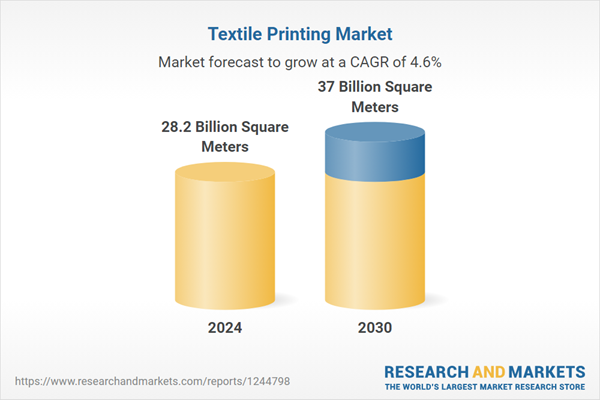The global market for Textile Printing was sized at 28.2 Billion Square Meters in 2024 and is projected to reach 37.0 Billion Square Meters by 2030, growing at a CAGR of 4.6% from 2024 to 2030. This comprehensive report provides an in-depth analysis of market trends, drivers, and forecasts, helping you make informed business decisions. The report includes the most recent global tariff developments and how they impact the Textile Printing market.
Segments: Technology (Screen Printing, Digital Printing); Fabric Type (Apparel, Interior / Furnishings, Industrial / Technical Textiles).
Geographic Regions/Countries: World; USA; Canada; Japan; China; Europe; France; Germany; Italy; UK; Spain; Russia; Turkey; Rest of Europe; Asia-Pacific; Australia; India; South Korea; Rest of Asia-Pacific; Latin America; Brazil; Mexico; Rest of Latin America; Middle East; Africa.
The analysts continuously track trade developments worldwide, drawing insights from leading global economists and over 200 industry and policy institutions, including think tanks, trade organizations, and national economic advisory bodies. This intelligence is integrated into forecasting models to provide timely, data-driven analysis of emerging risks and opportunities.
Global Textile Printing Market - Key Trends & Drivers Summarized
What Is Textile Printing and Why Is It Crucial to the Industry?
Textile printing is the process of applying color to fabric in definite patterns or designs. In properly printed fabrics, the color is bonded with the fiber to resist washing and friction. This art has been evolving for centuries, starting from ancient block printing methods to the advanced digital printing technologies we see today. Textile printing is crucial as it adds aesthetic value to fabrics, making them more appealing for fashion and interior design applications. The versatility in design and color possibilities offered by textile printing makes it a cornerstone of the textile industry, enabling endless creativity and innovation.How Have Technological Advancements Transformed Textile Printing?
The advent of new technologies has revolutionized textile printing, making it more efficient, versatile, and environmentally friendly. Traditional methods like screen printing and rotary printing are now complemented by advanced techniques such as digital printing. Digital textile printing, which uses inkjet technology to print designs directly onto fabric, offers numerous advantages including reduced waste, lower water usage, and the ability to produce short runs economically. This method also allows for high precision and the ability to create complex designs that would be difficult to achieve with traditional printing. Furthermore, advancements in dye-sublimation printing have enabled the creation of vibrant, durable prints on synthetic fabrics, expanding the range of possibilities for textile designers.What Are the Emerging Trends in Textile Printing?
The textile printing industry is experiencing several emerging trends that reflect changes in consumer preferences and technological advancements. Sustainability is a major trend, with a growing emphasis on eco-friendly printing methods and materials. Water-based inks and digital printing technologies that reduce water and chemical usage are gaining popularity. Customization and personalization are also driving the market, with consumers seeking unique, bespoke designs. This trend is facilitated by digital printing, which allows for on-demand production and rapid design changes. Additionally, the integration of smart textiles, which embed digital technology into fabrics, is opening new avenues for innovation in textile printing. This includes printing conductive inks and other components that can interact with digital devices, offering new functionalities and applications.What Drives the Growth in the Textile Printing Market?
The growth in the textile printing market is driven by several factors, including technological advancements, increasing demand for customized and sustainable textiles, and the expanding applications of printed fabrics. Technological innovations, such as digital and dye-sublimation printing, are enhancing the efficiency and versatility of textile printing, making it more accessible to a broader range of industries. The rising consumer demand for personalized and unique textile products is also boosting the market, as digital printing enables easy customization and short production runs. Moreover, the fashion industry's constant push for new trends and designs is propelling the demand for innovative textile printing solutions. Regulatory pressures and consumer awareness about environmental sustainability are encouraging the adoption of eco-friendly printing technologies. These factors collectively ensure the dynamic growth of the textile printing market, aligning it with contemporary technological and consumer trends.Report Scope
The report analyzes the Textile Printing market, presented in terms of units. The analysis covers the key segments and geographic regions outlined below.Segments: Technology (Screen Printing, Digital Printing); Fabric Type (Apparel, Interior / Furnishings, Industrial / Technical Textiles).
Geographic Regions/Countries: World; USA; Canada; Japan; China; Europe; France; Germany; Italy; UK; Spain; Russia; Turkey; Rest of Europe; Asia-Pacific; Australia; India; South Korea; Rest of Asia-Pacific; Latin America; Brazil; Mexico; Rest of Latin America; Middle East; Africa.
Key Insights:
- Market Growth: Understand the significant growth trajectory of the Screen Printing segment, which is expected to reach 27.6 Billion Square Meters by 2030 with a CAGR of a 2.5%. The Digital Printing segment is also set to grow at 13.3% CAGR over the analysis period.
- Regional Analysis: Gain insights into the U.S. market, sized at 1.7 Billion Square Meters in 2024, and China, forecasted to grow at an impressive 5.6% CAGR to reach 11.3 Billion Square Meters by 2030. Discover growth trends in other key regions, including Japan, Canada, Germany, and the Asia-Pacific.
Why You Should Buy This Report:
- Detailed Market Analysis: Access a thorough analysis of the Global Textile Printing Market, covering all major geographic regions and market segments.
- Competitive Insights: Get an overview of the competitive landscape, including the market presence of major players across different geographies.
- Future Trends and Drivers: Understand the key trends and drivers shaping the future of the Global Textile Printing Market.
- Actionable Insights: Benefit from actionable insights that can help you identify new revenue opportunities and make strategic business decisions.
Key Questions Answered:
- How is the Global Textile Printing Market expected to evolve by 2030?
- What are the main drivers and restraints affecting the market?
- Which market segments will grow the most over the forecast period?
- How will market shares for different regions and segments change by 2030?
- Who are the leading players in the market, and what are their prospects?
Report Features:
- Comprehensive Market Data: Independent analysis of annual sales and market forecasts in US$ Million from 2024 to 2030.
- In-Depth Regional Analysis: Detailed insights into key markets, including the U.S., China, Japan, Canada, Europe, Asia-Pacific, Latin America, Middle East, and Africa.
- Company Profiles: Coverage of players such as aeoon Technologies GmbH, AM Printex Solutions, ATPColor Srl, Bordeaux Digital PrintInk Ltd., Durst Group AG and more.
- Complimentary Updates: Receive free report updates for one year to keep you informed of the latest market developments.
Some of the 226 companies featured in this Textile Printing market report include:
- aeoon Technologies GmbH
- AM Printex Solutions
- ATPColor Srl
- Bordeaux Digital PrintInk Ltd.
- Durst Group AG
- Hollanders Printing Solutions
- JV Digital Printing
- Mehler Texnologies GmbH
- Seiko Epson Corporation
Tariff Impact Analysis: Key Insights for 2025
Global tariff negotiations across 180+ countries are reshaping supply chains, costs, and competitiveness. This report reflects the latest developments as of April 2025 and incorporates forward-looking insights into the market outlook.The analysts continuously track trade developments worldwide, drawing insights from leading global economists and over 200 industry and policy institutions, including think tanks, trade organizations, and national economic advisory bodies. This intelligence is integrated into forecasting models to provide timely, data-driven analysis of emerging risks and opportunities.
What’s Included in This Edition:
- Tariff-adjusted market forecasts by region and segment
- Analysis of cost and supply chain implications by sourcing and trade exposure
- Strategic insights into geographic shifts
Buyers receive a free July 2025 update with:
- Finalized tariff impacts and new trade agreement effects
- Updated projections reflecting global sourcing and cost shifts
- Expanded country-specific coverage across the industry
Table of Contents
I. METHODOLOGYMII. EXECUTIVE SUMMARY2. FOCUS ON SELECT PLAYERSIII. MARKET ANALYSISFRANCEGERMANYSPAINRUSSIAREST OF EUROPEAUSTRALIASOUTH KOREALATIN AMERICABRAZILMEXICOREST OF LATIN AMERICAIV. COMPETITION
1. MARKET OVERVIEW
3. MARKET TRENDS & DRIVERS
4. GLOBAL MARKET PERSPECTIVE
UNITED STATES
CANADA
JAPAN
CHINA
EUROPE
ITALY
UNITED KINGDOM
TURKEY
ASIA-PACIFIC
INDIA
REST OF ASIA-PACIFIC
MIDDLE EAST
AFRICA
Companies Mentioned (Partial List)
A selection of companies mentioned in this report includes, but is not limited to:
- aeoon Technologies GmbH
- AM Printex Solutions
- ATPColor Srl
- Bordeaux Digital PrintInk Ltd.
- Durst Group AG
- Hollanders Printing Solutions
- JV Digital Printing
- Mehler Texnologies GmbH
- Seiko Epson Corporation
Table Information
| Report Attribute | Details |
|---|---|
| No. of Pages | 634 |
| Published | April 2025 |
| Forecast Period | 2024 - 2030 |
| Estimated Market Value in 2024 | 28.2 Billion Square Meters |
| Forecasted Market Value by 2030 | 37 Billion Square Meters |
| Compound Annual Growth Rate | 4.6% |
| Regions Covered | Global |









